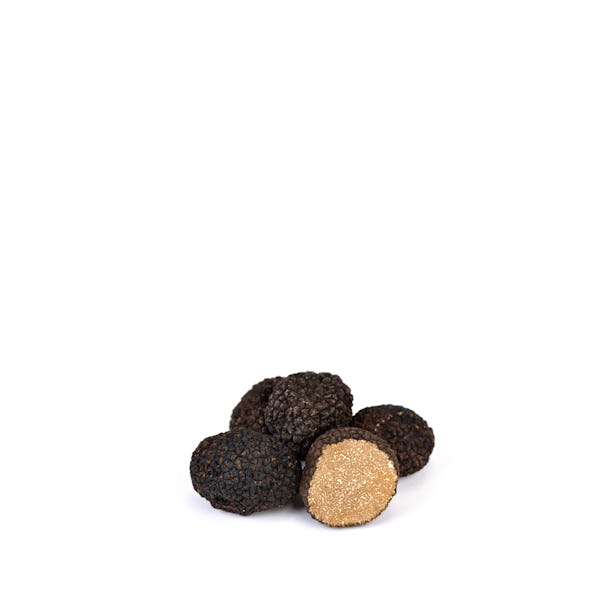
Fresh Summer Black Truffles from France
Black Diamond of Truffles
Tasting Notes from the Curator
Though French truffles can be found in Bourgogne, Provence, Occitanie, Lorraine, and Champagne, it is the Périgord region that is called the Truffle Capital of France. Found at the base of oak and hazelnut trees, these prized fungi have a unique pungency and their elusiveness only adds to their value.
Currently in season:
- The summer truffle (Tuber aestivum): Known in some parts of France as “la maïenque”, the May truffle, it is available from April to August. It tends to be larger than the autumn and winter species, with a paler interior. It is the subtlest of the black truffles from France, with a delicate hazelnut perfume and a mild earthy, almost caramel-creamy, taste on the tongue.
Other variants (currently not in season):
-
The autumn truffle (Tuber uncinatum): Also known as the Burgundy truffle, this close relative of the summer truffle is available from September to November. It is large, almost brown in color, with diamond-shaped “warts” on its skin. It has a nutty, chocolatey smell and taste, and is the second-best-known truffle in France.
-
The winter truffle (Tuber melanosporum): The crown jewel of the Périgord region, this French black truffle is only available from November to mid March. It is black with delicate white veining inside and is intense in aroma and taste. Its scent is earthy with a touch of dried fruit, and it leaves a long-lasting, memorable aftertaste on the tongue.
Preparation and Pairings
You only need a little truffle to elevate a dish. The best rule is to keep it simple, to allow the rich earthiness of the truffle to shine. Using a truffle shaver instead of a regular peeler or a knife gives you paper-thin slices that bring out the most flavor. Alternatively, you can use a microplane to get smaller slivers, depending on your recipe. Most dishes only require about 10 grams of truffle per person.
Pastas, rice, eggs, and even potatoes make excellent bases for your truffle dining pleasure. Truffles are best used right at the end of the cooking process, grated or sliced into soups or sauces as a finishing touch or in the last few minutes on a flame. Shave them raw over fish or chicken dishes or canapés. You can insert slivers under the skin of whole chickens or other poultry the night before roasting. Or, of course, you can grate pieces into butter or cream or even mayonnaise.
For wine pairings, truffles go best with wines that are not heavily aromatic. Your choice ultimately depends on your overall dish, but here are a few recommendations. Among white wines, we suggest wines from the Rhineland, an Italian Riesling, or a Verdicchio with a slightly bitter aftertaste. For red wines, go soft, rather than full-bodied, with the smooth tannins of a Nebbiolo or Pinot Noir.
A Fungi with Its Own History
Some of the earliest records on truffles come from Egypt, when Pharaoh Khufu built the Great Pyramids of Giza. He offered truffles as delicacies to dignitaries from all over the world. Truffles reached France when Francois I took the then-humble peasant foraging (often boiled like a potato!) to his own table in the 16th century. This culinary treasure truly came into its own in the 19th century, when Baron Bertrand de Malet planted oak trees in Sorges, a commune of France that is now part of the Périgord region. His method of truffle farming turned the region’s declining wine fortunes—the vines were dying from a viral infestation—around with plantations of truffle oaks. This has earned Périgord its reputation as the Truffle Capital of France.
Disclaimer on Availability of Pre-Ordered Air-Flown Items
This is a pre-ordered item at The Bow Tie Duck and will only be available while the producer from overseas is able to supply and allow air-flown delivery. Because this item is subject to seasonal availability, we require a minimum quantity of total orders to be able to ship. If the minimum is not met by our cut-off date, we will have to delay the entire shipment. In case of delivery delays, delivery cancellations, “out of stock” notices, or “out of season” notices after purchase, you will be contacted by our Support Team. You will receive a refund or product replacement, or you can choose a new delivery date for your item. In choosing to place an order, you agree to the terms and have read that this particular product is not on-hand. After a short wait, you will receive your orders fresh from the source.
Storage Instructions
For the best taste and quality, consume fresh truffles within 2 or 3 days of their arrival. If you need to store them longer, gently wrap the truffles in paper towels and place them in a dry, sealed container like tupperware or a glass jar. Keep the container in the crisper compartment of your refrigerator (no lower than 3°C) for up to one week.
